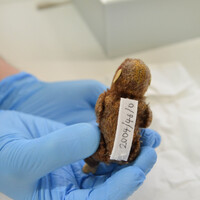Toy Monkey
A Talisman, a Good Luck Piece...
Gert Berliner (Aug. 25, 1924 - Mar. 27, 2019) was born in Berlin, Germany, to parents Sophie and Paul. As a child, he received a toy monkey, likely gifted to him by his parents. Gert treasured his toy and considered it his talisman, his good luck piece. Together, Gert and the toy monkey explored the streets of the city's Bavarian Quarter; the toy monkey leading the way, strapped to the handlebars of Gert’s bicycle.
In 1933, the Nationalist Socialist Party came to power, and after the events of Kristallnacht on November 9 and 10, 1938, it was clear to Gert’s parents that Germany was no longer safe. Sophie and Paul were able to arrange Gert’s escape on a Kindertransport bound for Sweden. Gert traveled alone with only a small suitcase, tucked away in that suitcase was the toy monkey. In 1943, Gert's parents were deported to Auschwitz, where they were murdered.
In 1947, at the age of 22, Gert left Sweden for New York, again, bringing with him the toy monkey. Gert would keep his good luck charm with him for over 60 years of his life. In 2003, he donated the toy monkey to the Jewish Museum in Berlin, under the care of archivist Aubrey Pomerance. The toy monkey has been displayed in two separate exhibits since its donation. In 2015, the toy monkey was discovered by a visitor of the museum, Erika Pettersson, who realized that the owner of the toy shared the same family name as her mother, Berliner. Returning home to Sweden, Erika told her mother about the toy monkey, whose curiosity led to a remarkable discovery of a family connection. Since the discovery of a thriving extended family in Sweden, Gert's son, Uri Berliner, has extensively researched his father's history. Uri broadcasted the toy monkey's story on NPR (National Public Radio) in November 2018.
To learn more about Gert's toy monkey and how it connected a family, please see the following NPR links:
"A Toy Monkey That Escaped Nazi Germany And Reunited A Family" - Audio of an interview of Gert Berliner, conducted by Uri Berliner. Story written by Uri Berliner
"How A Stuffed Toy Monkey Reunited A Holocaust Survivor With Relatives" - Transcription of an interview of Gert and Uri Berliner, conducted by Michel Martin
"The Cost Of Courage: The 2 Couples Who Rescued My Family From The Nazis" - Written by Uri Berliner
To read transcripts of interviews with Gert's son, Uri Berliner, and Jewish Museum in Berlin archivist, Aubrey Pomerance, please see the following links.
To read the full interview with Uri Berliner, click here.
Transcript and metadata of an interview with Uri Berliner.
To read the full interview with Aubrey Pomerance, click here.
Transcript and metadata of an interview with Aubrey Pomerance
At the Museum...
When not on display, the toy monkey is kept in the Jewish Museum in Berlin's textile depository in the basement of the Daniel Libeskind building. It is a climate controlled depository, kept within a one-degree range of 18 degrees Celsius and at a humidity of 50 percent. The Toy Monkey has been cared for and packaged by a textile conservator. All of the museum's textile objects are viewed and analyzed by the textile conservators, who write reports about their condition and what needs to be done if one wants to restore it. The monkey is packaged in tissue paper in a box with other materials.
The toy monkey was on display for four years on the lower floor of the museum. It was displayed in a hallway called Axis of the Holocaust. This passageway features material that relates to individuals and families of whom members were deported and murdered during the Holocaust. Although Gert survived, his parents did not. They were deported and murdered in 1943.
Before the donation of the toy monkey, Gert had donated other materials to the Jewish Museum in Berlin, including letters he received from his parents prior to their deportation. At one point, the toy monkey was accompanied by a censored letter that Gert’s parents had written in November of 1941 to him in Sweden. Other letters written by Gert’s parents have also been displayed in the Axis of the Holocaust passageway. For conservation reasons, these artifacts may only be displayed for limited amounts of time.
To learn more about the censored letter at the Jewish Museum, click here.
Around the World...
Gert took the toy monkey with him during his escape from Berlin to Sweden, immigration to the United States, living in Italy, and returning to New York. In 2003, Gert brought the monkey to its new home at the Jewish Museum in Berlin.
The Response...
NPR reached out to listeners and readers to tell their own stories of fleeing conflict and what they brought with them. To learn more about the response to Uri Berliner's original broadcast please see the following links:
"What They Took With Them As They Fled Conflicts" - Contributors are NPR's Uri Berliner, Alec Cowan, Wynne Davis, Phil Harrell, Gerry Holmes, Caroline Kelly, Adelina Lancianese, Michael May and Avie Schneider
"For A Boy From Cuba, A Stranger's Crucifix Was A Symbol Of Kindness" - Transcription of an interview of Jose Linares, conducted by Debbie Elliott
To see the toy monkey's story posted on Facebook by NPR and the reactions of viewers, click here.
Sadly, Gert Berliner passed away on March 27, 2019, surrounded by his family. Gert’s testimony will endure and continue to reach and touch others through the story of his beloved toy monkey.
May his memory be a blessing.











